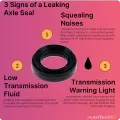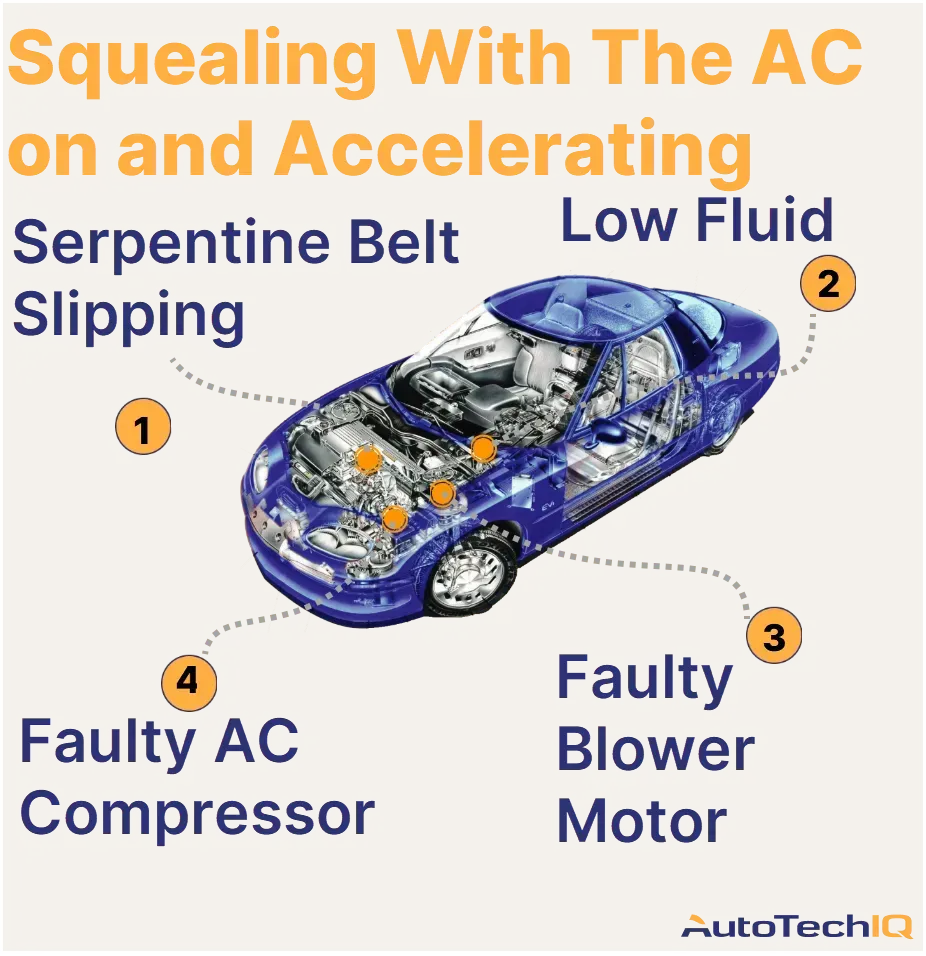
If you’re accelerating the car while the AC is on and hearing a squealing noise, the culprit is probably a slipping serpentine belt. This belt drives the AC compressor, making your air conditioner work properly. But, if the belt is misaligned or out of place, it’ll spin erratically the more you accelerate with the AC on.
The issue can also be internal damage in the AC compressor or its pulleys, which can overstress as the vehicle drives, making the squealing sound more noticeable.
Watch out: The squealing noise can mean problems under the hood or internally in AC-related components. This type of issue can lead to more electrical failures and damaging movement under the vehicle. In worst cases, the engine and alternator can break down.
When accelerating with the AC on, the squealing noise means that something related to the air conditioner is faulty, and accelerating the car overstresses it further. Here are some of the main risks possibly related to it:
-
Serpentine problems: The serpentine belt could be misaligned or out of place. This means the belt is either loose or banging against other components. Since the belt is vital for many of the vehicle’s systems, this could lead to various problems beyond the AC squealing noise. Moreover, a loose serpentine belt can damage nearby components.
-
Electrical issues: If the issue relates to the AC compressor and its pulleys, the problem might be electrical-related and could mean further damage to fuses, wiring, and the serpentine belt. The squealing sound can be from overstressing the system.
-
Safety risks: If the issue relates to the serpentine belt, many of the vehicle’s electrical functions like the power steering and engine cooling can fail. This leads to tougher steering and engine breakdowns. If the issue relates to the AC’s internal components, it can mean that the air conditioner’s airflow is bad, making it easier to develop mold, which can trigger allergies.
The most common causes for a car squealing when accelerating with the AC on
Here are the most common issues causing your car to squeal when accelerating with the AC on:
Frequently Asked Questions
Q: How often should I take my vehicle for AC maintenance?
Have your vehicle's AC system checked and serviced at least once a year. However, if you notice issues such as reduced cooling performance, strange noises, or odd smells, you should have it inspected sooner. Regular maintenance includes checking refrigerant levels, inspecting the compressor, belts, and hoses, and ensuring the system is clean and functioning efficiently.
Q: Should I drive if my car AC is squealing?
Driving with a squealing AC system can lead to further damage, such as belt failure or engine overstress. The squeal only points out there’s a problem, and ignoring it is allowing the issue to progress. The best approach is to stop enabling the AC and avoid overusing the vehicle until the issue is checked.
Q: How long does refrigerant fluid last in the AC?
The refrigerant in the AC system is designed to last for the life of the vehicle under normal conditions, as it is a closed-loop system. However, it can slowly leak over time due to small imperfections or damage to components like hoses, seals, or the compressor. If it refrigerant level is too low, it'll cause damage to AC components, leading to a squealing or hissing noise.
Typical fixes to address the cause(s)
These are typical processes and repair services that fix a burning rubber issue
-
Serpentine Belt Replacement
-
Wheel bearing Replacement
-
Brake pad Replacement
-
Alignment service
-
Power steering top off
-
Suspension maintenance
The most common cause: Serpentine Belt
Most commonly, the serpentine belt, which runs under the vehicle’s hood, is loose or misaligned around the AC compressor’s pulley. Then, whenever you engage the AC, the loose belt and the pulley start spinning erratically, which can intensify depending on how the vehicle is driving, leading to a loud screeching noise.
-
Origin of the sound: Under the hood
-
Symptoms it causes: Apart from the squealing noise you might notice poor airflow coming from the AC vents or a lack of cold air. A loose serpentine might also cause issues on the radio, cabin lights, and power steering.
-
High risk of priority: The serpentine belt is essential for the vehicle’s electrical system, including the power steering which helps in controlling and maneuvering. If the belt is loose or faulty, some of the vehicle’s accessories can become jerky or damaged.
What exactly is a serpentine belt?
The serpentine belt is a looped rubber belt that’s under the vehicle’s hood. The belt is triggered by the engine to run along grooves on pulleys attached to the alternator, power steering pump, air conditioner compressor, and water pump (in some cases).
-
Key function: The serpentine belt receives engine power and starts spinning, rotating the pulleys of the alternator, power steering pump, air conditioning compressor, and sometimes the water pump. This rotation generates power, feeding your car’s A/C, radio, accessories, lights, etc, with electricity.
Although a slipping or worn-out serpentine belt commonly causes squealing noises in a vehicle, it’s not always the culprit. Many other car parts can lead to a squealing sound when they fail.
Go safe: Ask for a mechanic to inspect your vehicle to track the squealing sound’s location and how it affects other components. Many shops do transparent vehicle inspections and lay out your options after investigating your vehicle’s conditions.
What’s a vehicle inspection? It’s “detective work” on your vehicle, checking its systems to find if anything is preventing the car from working as expected. In this case, mechanics examine different parts of your vehicle to track where the squealing noise is coming from and what’s causing it. They’ll also check the condition of components during their inspection, noting which are causing the problem and which got affected by it, recommending to replace them in order of priority.
Transparency example in a serpentine belt service
Let’s see how a vehicle inspection helps the car owner decide what service they’ll proceed with to fix a squealing noise from the AC issue.
In this example, the technician heard the customer complain about the vehicle making squealing sounds when the AC was on; the sound seemed noticeable when accelerating. The expert started an investigation by checking under the vehicle’s hood. When checking the AC compressor, the technician noticed that the serpentine belt was loose around its pulley.
The loose serpentine belt already had signs of damage, possibly due to the erratic movement it’s been making under the hood.
With these findings, the technician will inspect the other accessories that the serpentine belt works with, like the water pump, alternator, etc. If the serpentine belt has been spinning incorrectly for too long, it might have caused damage to nearby pulleys and components. Then, they'll plan a fix for the whole system.
The image below shows the loose and ripped belt, causing the squealing noise. Hence, replacing it is crucial to avoid future damage.

In this case, the mechanic put the “Immediate Action” tag on the serpentine belt. They also recommended replacing the compressor pulley since it got damaged by the serpentine’s jerky movement.
Other news
-
Car is Squealing When Driving
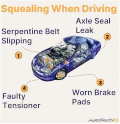
-
What is Preventative Maintenance and What Are The Benefits of it?

-
JobViewIQ - DVI Process Training - Part of the Auto Care Alliance Benefits

-
7 Signs of AC Pulley Issues
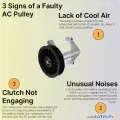
-
7 Signs of Clogged AC Components
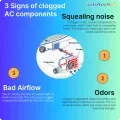
-
How Much Does a Transmission Fluid Change Cost?

-
7 Signs of a Leaking Axle Seal
